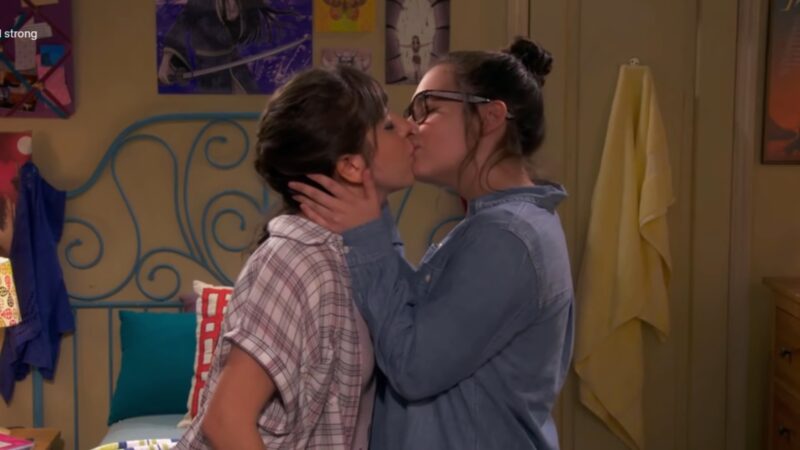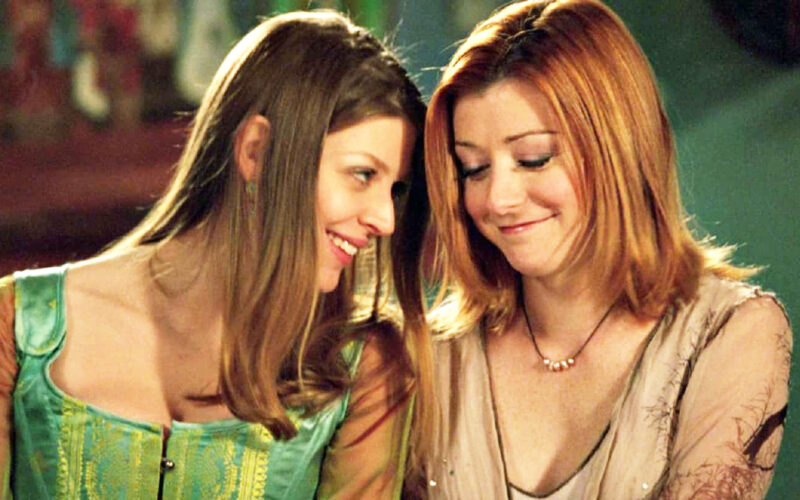The power of representation in media is undeniable. For many LGBTQ+ individuals, seeing oneself reflected on the screen can be a profound experience. Today, let’s celebrate the iconic lesbian and sapphic kisses that not only brought visibility but also broke boundaries, challenged societal norms, and inspired countless viewers.
10. Clarke and Lexa in “The 100”
In the dystopian world of “The 100”, Clarke Griffin and Commander Lexa found solace in each other. Their relationship, filled with political tension and personal stakes, culminated in a kiss that was both a revelation and a turning point for both characters.
More than Just a Moment
The relationship between Clarke and Lexa was complex and multi-dimensional. Their kiss wasn’t just a fleeting moment but symbolized their shared challenges, leadership burdens, and the possibility of love amidst chaos.
The Impact and Controversy
While Clarke and Lexa’s relationship was celebrated for its representation, it also sparked conversations about the treatment of LGBTQ+ characters in media, particularly around the “Bury Your Gays” trope. Their storyline serves as a reminder of the responsibilities that come with representation.
9. Annette and Merteuil in “Cruel Intentions”

Set amidst the backdrop of New York’s elite society, the unexpected kiss between Annette (Reese Witherspoon) and Merteuil (Sarah Michelle Gellar) was a moment of sheer seduction. While part of Merteuil’s manipulative games, the kiss remains one of the film’s most iconic scenes.
Pushing Boundaries in Cinema
“Cruel Intentions,” released in 1999, was provocative in its content. The inclusion of a sapphic kiss, especially between two lead characters, challenged Hollywood norms and generated significant buzz.
A Moment in Time
While the kiss was brief and the motivations behind it were questionable, it stands as a defining moment in late 90s cinema. It showcased the fluidity of desire and became a cultural touchstone for many.
8. Waverly and Nicole in “Wynonna Earp”
In the supernatural realm of Purgatory, Waverly Earp and Sheriff Nicole Haught found each other. Their magnetic chemistry was undeniable from the start, leading to kisses that were both tender and fiery, reflecting the depth of their bond.
Fan Favorites from the Get-Go
The #WayHaught ship rapidly became a fan favorite. Their relationship was treated with respect and depth, offering a refreshing representation of lesbian love amidst a backdrop of demons and supernatural battles.
A Legacy of Representation
“Wynonna Earp,” while a genre show, made significant strides in LGBTQ+ representation. Waverly and Nicole’s relationship played a pivotal role in this, proving that love stories, no matter the setting, can be both universal and unique.
7. Nomi and Amanita in “Sense8”
In a show that celebrated interconnectedness across cultures and continents, Nomi and Amanita’s relationship was a beacon of hope and love. Their passionate kisses, filled with intensity and emotion, epitomized the show’s central theme – the universality of human connection.
Challenging Norms and Breaking Stereotypes
“Sense8” was groundbreaking in its representation of diverse sexualities and genders. Nomi, a transgender woman, and Amanita’s relationship showcased the struggles and joys of a queer couple, breaking many stereotypes along the way.
A Celebration of Love
Amidst the sci-fi elements and global adventures of “Sense8”, the love between Nomi and Amanita stood out. Their bond was a testament to the fact that love transcends all boundaries, be they cultural, geographical, or societal.
6. Callie and Arizona in “Grey’s Anatomy”
As two accomplished surgeons in the bustling world of Grey Sloan Memorial Hospital, Callie Torres and Arizona Robbins found love amidst the chaos. Their first kiss, spontaneous and joyous, was a moment of pure delight for fans who had been rooting for their union.
Changing Narratives on Primetime TV
“Grey’s Anatomy,” a primetime juggernaut, has been applauded for its diverse cast and storylines. Introducing a prominent lesbian relationship was yet another feather in its cap. Through Callie and Arizona, the show delved deep into the challenges and triumphs of a same-sex relationship, setting the tone for many other shows to follow.
A Roller Coaster of Emotions
While their journey together had many ups and downs, the authenticity of Callie and Arizona’s relationship resonated with many viewers. Their love story remains one of the most memorable arcs in the series, showcasing the complexities of love, commitment, and personal growth.
5. Alex and Marissa in “The O.C.”

Their kiss, passionate yet filled with uncertainty, perfectly captured the essence of young love and exploration. Alex and Marissa’s brief relationship was a significant plotline in “The O.C.” It showed the fluidity of sexuality and how personal experiences could shape one’s identity.
Media Buzz and Impact
When the kiss aired, it generated substantial media buzz. While some critics dismissed it as a ratings ploy, others appreciated the boldness of showcasing a same-sex relationship in a popular teen drama.
Beyond the Sensation
Despite the controversies, Alex and Marissa’s relationship brought visibility to lesbian relationships in mainstream teen television. Their experiences, while dramatized, shed light on the complexities of coming to terms with one’s sexuality.
4. Carol and Therese in “Carol”
Set in the 1950s, “Carol” is a masterful depiction of a forbidden romance. The electrifying kiss between Carol and Therese, played brilliantly by Cate Blanchett and Rooney Mara, is a symbol of their silent defiance against a repressive society. Every stolen glance leading up to the kiss is charged with unsaid emotions, making their connection palpable.
Transcending the Screen
Director Todd Haynes meticulously crafted a world where the societal constraints of the time were evident. But amidst the repression, the rawness of Carol and Therese’s emotions shone through, proving that love knows no bounds.
An Ode to Timeless Romance
While “Carol” is set in a bygone era, the universality of its love story continues to resonate. Their kiss serves as a reminder that love can bloom even in the harshest of environments.
3. Elena and Peyton in “One Day at a Time”

One Day at a Time’s reboot provided a fresh take on coming-out narratives with Elena’s character. When she shares her first kiss with Peyton, it’s a sweet culmination of her journey towards self-acceptance. The innocence and joy of their teenage love were beautifully captured, offering a hopeful glimpse into a more inclusive future.
The Significance of Family
The show places a strong emphasis on family dynamics. Elena’s coming out, and her relationship with Peyton are integral to this theme. Their kiss wasn’t just about them, but also about Elena’s family learning to embrace her identity. The Alvarez family’s acceptance set a positive example for households everywhere.
A Modern Representation
Elena and Peyton’s storyline is a testament to how far LGBTQ+ representation has come. Their relationship is not just accepted but celebrated, showing younger viewers the possibilities of love in all its forms.
2. Bette and Tina in “The L Word”
Bette and Tina’s tumultuous relationship provided viewers with a nuanced exploration of the ups and downs of a long-term lesbian relationship. Their passionate kisses were filled with chemistry, reflecting the depth of their bond. However, it wasn’t just about the physical connection; their emotional intricacies were depicted with equal fervor.
Pushing the Envelope
“The L Word” was revolutionary in its portrayal of lesbian lives and loves. The series was unapologetic in showcasing a variety of queer women’s experiences. Bette and Tina, as central characters, became symbols of the complexities inherent in loving relationships, lesbian or otherwise.
An Everlasting Impact
While the show had its share of criticisms, the depth and authenticity of Bette and Tina’s relationship resonated with many viewers. Their journey provided a template for many subsequent lesbian storylines, showcasing the realities of love, betrayal, and redemption.
1. Willow and Tara in “Buffy the Vampire Slayer”
Willow Rosenberg and Tara Maclay’s relationship remains one of television’s most celebrated same-sex couples. Their slow-burning romance was handled with grace and tenderness.
Their first on-screen kiss was all the more impactful because it wasn’t sensationalized; it took place in a quiet, intimate moment amidst the turmoil of Buffy’s mother’s death. The subtlety underscored that their love was just as valid and real as any other couple’s.
Breaking Boundaries in Mainstream TV
The importance of this kiss extends beyond the episode. At a time when LGBTQ+ representation was sparse on TV, particularly in popular teen shows, this portrayal of a same-sex relationship was groundbreaking. It paved the way for other queer storylines and normalized lesbian relationships for many viewers.
The Legacy Lives On
Years later, the impact of Willow and Tara’s relationship can still be felt. Their story remains a testament to the power of representation, showing that love is universal, regardless of gender or sexuality.
FAQs
Why is representation of lesbian and sapphic relationships in media important?
Representation matters because it validates the experiences of LGBTQ+ individuals. Seeing oneself reflected on screen can foster self-acceptance, decrease feelings of isolation, and build a sense of community. Moreover, positive representation helps to challenge and change societal perceptions, fostering a more inclusive and understanding society.
Are there any negative repercussions of showcasing sapphic relationships on screen?
While positive representation can have numerous benefits, mishandling of sapphic relationships can perpetuate harmful stereotypes or lead to tokenism. Additionally, if these relationships are consistently portrayed in a tragic or negative light, it can perpetuate the “Bury Your Gays” trope, which can be damaging to LGBTQ+ audiences.
How has the portrayal of sapphic relationships evolved over the years in media?
Historically, sapphic relationships were often coded, implied, or relegated to subtext due to censorship and societal norms. Over the years, as societal acceptance grew, so did the visibility and complexity of these relationships on screen.
Today, we see a broader range of sapphic stories, from casual representation in mainstream media to detailed explorations in LGBTQ+-focused content.
Are there any iconic sapphic relationships or kisses from non-English media or films?
Absolutely! LGBTQ+ representation is a global phenomenon. Cinema and TV from various countries have showcased memorable sapphic relationships. For example, in South Korean cinema, “The Handmaiden” has been praised for its portrayal of a lesbian relationship.
Similarly, other countries’ film industries have their own iconic moments and characters that have resonated with audiences worldwide.
Why do some sapphic relationships on screen face criticism even within the LGBTQ+ community?
Representation is multifaceted, and not every portrayal will resonate with every viewer. Some criticisms arise when characters or relationships are seen as stereotypes, lack depth, or are written without genuine understanding or respect for the LGBTQ+ experience.
Additionally, concerns about the lack of diversity or intersectionality in portrayals can also be a source of criticism.
How can filmmakers ensure authentic and positive sapphic representation in their work?
Authentic representation often comes from informed and empathetic storytelling. This can be achieved by involving LGBTQ+ individuals in the creative process, whether as writers, consultants, or actors. Research, sensitivity readings, and open dialogues with the community can also ensure that the portrayal is respectful and resonates with audiences.
Final Words
In celebrating these unforgettable sapphic moments, we recognize the progress made in media representation over the years. From barrier-breaking early portrayals to nuanced modern-day relationships, these kisses signify the evolving narrative of lesbian love on screen.
As we embrace a future with even more diverse storytelling, let these iconic moments serve as milestones on the journey of representation. In the spirit of this representation, we’ve recently written about celebrities who proudly identify as lesbians, so make sure to check it out!
